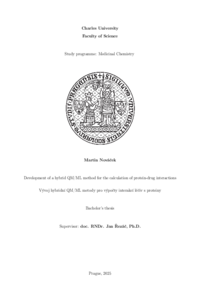Development of a hybrid QM/ML method for the calculation of protein-drug interactions
Vývoj hybridní QM/ML metody pro výpočty interakcí léčiv s proteiny
bachelor thesis (DEFENDED)

View/
Permanent link
http://hdl.handle.net/20.500.11956/199999Identifiers
Study Information System: 279261
Collections
- Kvalifikační práce [20831]
Author
Advisor
Referee
Andris, Erik
Faculty / Institute
Faculty of Science
Discipline
Medicinal Chemistry
Department
Department of Organic Chemistry
Date of defense
13. 6. 2025
Publisher
Univerzita Karlova, Přírodovědecká fakultaLanguage
English
Grade
Excellent
Keywords (Czech)
Kvantová chemie, strojové učení, protein-ligand interakce, počítačový návrh léčivKeywords (English)
Quantum chemistry, machine learning, protein-ligand interactions, computer-aided drug designPřes svou nespornou užitečnost je vývoj léků s pomocí výpočetní chemie limitován na přesnosti velikostí studovaného systému, která omezuje výpočetní náročnost použitelných metod. Jeden z možných postupů řešení tohoto problému je využití takzvaných ∆-ML metod, které kombinují robustnost a rychlost semiempirických kvantově mechanických metod s korekcí pomocí nejmodernějších technik strojového učení. Cílem této práce je pomocí tohoto přístupu vyvinout široce aplikovatelnou SQM/ML metodu, PM6-ML. Po dokončení trénování a vybrání nejvhodnějších modelů byla tato metoda otestována na několika datasetech relevantních pro vývoj léků a srovnána s podobnými metodami (Nováček and Řezáč, 2025).
Despite its significant strengths, computer-aided drug design is limited in accuracy by the size of the studied structure, which restricts the computational complexity of methods usable for this purpose. One possible way to tackle this issue is via so-called ∆-ML methods, combining the robustness and speed of semiempirical quantum mechanical methods with a state-of-the-art machine learning correction. Using this approach, this work aims to develop a broad, SQM/ML computational method, PM6-ML. After the completion of training and model selection, the method was tested on multiple datasets relevant for drug design, and compared against similar methods (Nováček and Řezáč, 2025).
